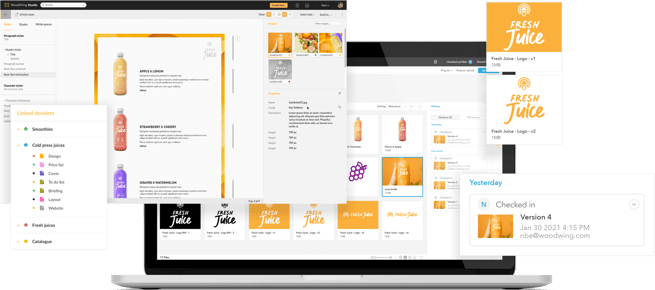Dubbed DAM 3.0, it is set to become the driver of omnichannel content, in a landscape where digital user experience is key.
Below we’ll explore:
- What the next generation of DAM - DAM 3.0 - has in store
- Why DAM 3.0 is ideal as an omnichannel content platform
- The four steps to progress from DAM to OCP
What is DAM 3.0 and why does it matter?
Next-generation DAM
DAM has been around for the past two decades and - like any software - has evolved during that time. Technological capabilities have advanced, new use cases have emerged, and users have demanded greater features and functionality from their software.
Growing with the market and its needs - and in tandem with advances in technology such as AI - DAM has developed beyond its original function as a digital asset library. Although the core purpose of DAM systems still delivers huge value to users - by making digital assets eminently discoverable, instantly accessible, and securely shareable - that only scrapes the surface of its potential.
From digital asset management to omnichannel content platform
Digital Asset Management systems can now be integrated with other software to deliver DAM functionality within existing apps. This speeds up content production and streamlines workflows by reducing the friction between software.
Repetitive actions like opening a new window, downloading assets from your DAM, then re-uploading them into a design application - for example - are eradicated. The ability to integrate injects powerful DAM search capabilities into other systems with less advanced asset functionality - like web content management systems.
This allows users to find their ideal digital asset, convert and optimize it for the web, and add it to their site in just a few clicks. But even this more advanced use of Digital Asset Management systems falls short of exploiting DAM’s full transformative potential.
The next evolution of Digital Asset Management puts DAM at the heart of omnichannel content production, publication, and distribution.

The phases of DAM maturity
According to software consultancy Real Story Group, there are three phases of DAM maturity. Value and complexity increase as you progress up the scale. We’ve taken inspiration from their assessment of the market in our description of the phases below.
DAM zero - No DAM
Suppose you have a DAM already, congratulations. You’re ahead of the millions of businesses still struggling to find their assets in a rabbit warren of file servers, folders, email inboxes, and desktops.
DAM 1.0 - DAM as a digital asset library
DAM 1.0 is what digital asset management systems were originally designed for. The system is used as a central repository for all of an organization's digital assets, making it much easier to store, search, share and access your files. However, there is minimal integration with other systems. Users tend to find their files, download them, and transfer them manually into other software.
DAM 2.0 - DAM as part of the Martech stack
DAM 2.0 is arguably the most common stage for current DAM users. The system is integrated with other software to streamline workflows and semi-automate some processes. For example, being able to search, save and use DAM contents from within design software or a CMS.
Some e-enterprises use DAM ‘headless’ as part of a content delivery network (CDN). This delivers digital assets directly into websites or apps behind the scenes and requires no DAM user interface. Like many mature DAM 2.0 deployments, this improves speed and efficiency by reducing manual intervention between content creation and consumption.
DAM 3.0 - DAM as an omnichannel content platform
DAM 3.0 is at the cutting edge of both technological capabilities and user needs.
It is being embraced and developed by early adopters as an omnichannel content platform (OCP). Omnichannel content means publishing the same content simultaneously across different channels - like your website, apps, print, and social media. An OCP is similar to a DAM in that it is a single source of truth for digital assets.
But it goes beyond traditional assets - like images and videos - to incorporate any assets needed to deliver an omnichannel experience. These might include text and data at the ‘atomic’ level.
DAM is a natural choice to manage complex ‘atomic’ content components thanks to sophisticated taxonomy, search-and-retrieve functionality, and AI-assisted tools. Whilst it’s data-based logic, peerless processing power, and established integrations with other software make it ideal for serving up highly relevant content at speed.
Sense check: what is omnichannel and ‘atomic’ content?
Unlike multichannel content - which uses multiple channels but may publish completely different content on each - omnichannel content presents the same information simultaneously across every customer touchpoint.
Whilst atomic content is the process of creating or repurposing content as ‘atoms’ that can be combined to create highly personalized, contextualized content. Put very simply, that just means using logic to combine and push out the right atoms, to the right people, at the right time.
Marketers that use three or more channels to connect with customers enjoy 250% more engagement and sales than marketers using a single channel. So delivering a consistent brand experience - wherever your audience is - makes great business sense.
And tools like DAM - which support content orchestration - make it easier for marketers to manage the huge upswing in the content they need to produce. In fact, in a recent report from Salesforce, 83% of marketers said their ability to meet customer expectations depends on their digital capabilities.
For more insights into this topic, check out our on-demand webinar: How to master atomic content with Content Orchestration.

How do I assess my DAM maturity?
Whilst the technology continually moves on, some businesses remain at an earlier stage of DAM development. This may be because their current setup suits their needs - or they are focusing on other digital transformation priorities.
Lower DAM maturity is only a cause for concern if it is holding back your business from achieving key objectives. Or if lack of awareness of DAM capabilities means you are under-utilizing a powerful - and potentially transformative - tool.
Where are you on the scale from DAM 1.0 to DAM 3.0?
Assess your current DAM level to build to the next. Check your DAM maturity with our two-minute diagnostic quiz
How to implement DAM 3.0 for omnichannel content management
STEP 1
Assess alignment with your strategic objectives
The first - and most important - question to ask about DAM 3.0 is… do you need it? Omnichannel content may be integral to one business’s strategy but entirely out of scope for another.
Creating an OCP is a complex and labor-intensive project - not something to be entered into lightly. Don’t feel DAM 3.0 needs to be your ultimate goal. If an earlier stage of maturity aligns better with your current strategic objectives, stay there... for now.
STEP 2
Establish your DAM 3.0 requirements
Once you’ve established that DAM 3.0 will be central to your strategic objectives, it’s time to think about the specific features and functionality you’ll need.
To do this, you’ll need to examine your current processes and workflows and work out where they can be improved.
As a starting point, identify:
- Your flow of information and data - both current and desired
- The unique components within your software ecosystem
- Possible integration touchpoints
STEP 3
Assess your DAM’s suitability as an OCP
The DAM market has hundreds of solutions, offering different levels of sophistication and maturity.
Your current DAM may - or may not - be suitable for your future plans. Talk to your current provider about whether their DAM can deliver your vision for omnichannel content. If not, you may need to look for a new DAM system. If you subscribe to DAM via the SaaS model (Software as a Service), it should be relatively easy to change providers - ease of switching is one of the key benefits of SaaS.
If your DAM is an on-premises solution, switching may be more of a challenge. You’ll need to include your IT team - as well as your DAM supplier - in any discussions about your future plans.
STEP 4
Conduct proof-of-concept modeling
Implementing an omnichannel content platform is likely to require integrating several different software solutions into a stack. There will be numerous workflows to consolidate and lots of stakeholders to engage.
In our experience, businesses that conduct comprehensive preliminary concept work enjoy higher success rates. By which we mean a better end product, easier rollout, and higher user adoption. This is because workflows are modeled and tested in advance, and any issues are ironed out before release.
You may have in-house IT resources to deliver this work. Or you may need to bring in an experienced IT partner to help. Either way, don’t skip this stage, as it is a strong predictor of future success.
WoodWing solutions - an integral part of your omnichannel content platform
WoodWing software is ideal for omnichannel content production. Major international brands like Yamaha Motor, BuzzFeed, Hearst and Bavaria have built a hyper-efficient omnichannel stack using WoodWing solutions. In the process, they have transformed their business processes, revolutionized their workflows and gained significant competitive advantage.
We offer two complementary products:
- WoodWing Assets - our powerful Digital Asset Management system
- WoodWing Studio - our multi channel content platform

As standalone products, they deliver significant workflow efficiencies. But combined, they’re truly transformative. And thanks to our best-in-class integrations that’s easier than ever to achieve.
Our integrations go beyond a few APIs, webhooks and plugins. We have a best-in-class iPaaS solution - WoodWing Connect - that lets our products integrate with hundreds of applications like Adobe InDesign and InCopy.
So you can reimagine your content production processes and rebuild them - better - around WoodWing’s powerful software solutions.



